Meditation Tips: This is the English version of my website. You will find all topics regarding meditation on this site.
This website
offers everything beginners and advanced meditators need for the practice of silence: meditation tips, answers, regular posts, pictures, hints and much more.
I invite you to look here, to read, to ask . . .
Sorry – at this moment only a certain portion is translated.
In the meantime please also have a look on the german pages. Some translation tools are not that bad.
There is a Forum – to answer your questions about meditation (you can ask in english).
There is also The Meditation Blog with an english translation of some of my German Blog Articles.
You can contact me: info@raumfuermeditation.d
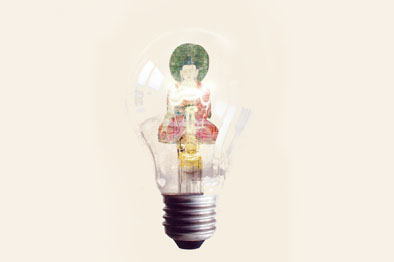
Meditation Tips – Here’s what you should know when you start meditation:
Posture
The back should be straight and rest in itself. Why? So the energy can flow well and you don’t get tired so quickly.
Breath
You are calm, quiet and breath flows naturally. This makes your mind calm.
mind
Most important is what your mind does. Mind, that are your thoughts and emotions. And more than thoughts and emotions. There is a state in which you are fully awake and yet there are no thoughts.
Thoughts tend to jump back and forth like a young cat. Therefore give the mind something to play with. This can be anything: an inspiring image, a candle flame, or an inwardly repeated syllable like: Om, Ah, Hum.
In the beginning, it is recommended to take care of the breath. It has the advantage that you always have it with you. You count the breaths from one to ten and then start again at one.
You watch how the breath flows through your nose, how it flows through the throat and bronchi into the lungs, how the abdominal wall lifts and how the abdominal wall lowers, how the lungs pull together and how the breath leaves the body over bronchi, throat and nose or mouth.
You will find that you have counted to 16 or have already stopped at 5. You were distracted. When you notice this, start again at one and count on quietly. If you’re annoyed, it’s just another distraction.
What Meditation Is
Meditation is a state in which the mind is not distracted and comes to rest. Like muddy water in a glass becomes clear if you don’t shake it any further.
There is nothing special to do. There is no need to think. The mind is on holiday. But beware! That doesn’t mean dozing.
You should be fully awake. Thoughts always come up. But you are not your thoughts. You’re here and over there are your thoughts.
What meditation is not
You can dance, sing, listen to music, go to the sauna, read an inspiring book, lie in warm body water, listen to a lecture, pray. This can do all well and help. This may be wellness, but not meditation.
So much for the moment. There is much more to say about meditation and meditation tips.

What is Meditation?
There are two meanings of “meditation”, on one hand, it’s a state of mind and, on the other hand, it’s a bundle of methods.
Meditation is a state of the Mind.
“Meditation is the state without distraction.” This is my favorite definition. I heard it from the lama Sogyal Rinpoche.
That is, of course, a high goal.
What is meditation? – A method
What we call meditating means practicing to get closer to this state. These methods are used to make the mind more flexible. It should no longer jump around like mice. Thoughts and emotions settle down.
What is meditation? – Different definitions
Meditation has many facets and stages.
Patanjali
Patanjali distinguishes concentration (dharana) and meditation (dhyana). To concentrate or fixate means, the mind is directed to a single point. Our thoughts and emotions no longer jump from one object to the next, but remain at one single place.
You can use an object to direct your mind. A meditation object can be anything. Popular meditation objects are one’s own breath, a sacred image, a sacred sound sequence (mantra).
This concentration on an object is the predominant form, which is practiced first and perhaps quite a long time.
Patanjali speaks of meditation (dhyana) only when it is possible to remain continuously in this fixation – an uninterrupted flow, evenly, without interruption, undistracted, quite calm.
Next is a meditation without any object, without any distraction, no intervention – just observation.
At some point there is a state in which even me and you is no longer existing. The ego is gone. No concepts. No reference point. Just wakefulness.
Osho
Osho sums it up this way: “And finally meditation. In ordinary thinking, mind may go wherever it wants; in contemplation, it may only move in a certain direction. In concentration, there is only the focus on one single point. And in meditation there is no mind at all. Meditation is no-mind.” (Osho, The Book of Secrets)
Looking inwardly
Meditation brings a change of direction: looking inward rather than outward, as we are used to. We are always concerned with external matters. Now we are searching for the one who acts, the inner witness. Mind notices itself.
Mindfulness
Mindfulness is necessary: I know, I’m here, this moment. I’m awake. Completely awake – no sleep, no dozing. Some thoughts and emotions can be in this state. Thoughts and emotions simply rise. That’s natural. There’s no need to suppresse them. But don’t hold them. It’s about letting go.
Don’t follow past thoughts, don’t anticipate future thoughts. Let mind settle down. Meditation is nothing you do – it happens.
meditation tips # 01
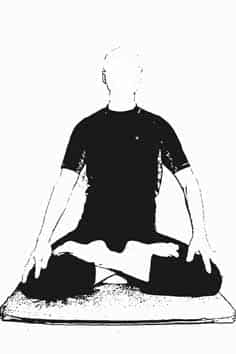
Meditation tips: Meditation Postures – How to sit in meditation?
This is the meditation tips about meditation postures, what meditation postures there are, to practice on a chair or on a pillow.
Sit in a comfortable posture
During meditation, you can sit on a normal chair or on a pillow. Basically, it is important to sit comfortably. The body should not disturb or distract us. The meditation posture should support your meditation.
Sitting on a chair
Don’t be afraid to meditate on a chair. Meditation doesn’t matter if you’re sitting on a pillow or on a chair. Sitting on a pillow seems more appropriate. But. Most of us are not used to it. You quickly will feel uncomfortable and maybe the legs hurt. If I only think of my legs and my knees, I can’t meditate . There’s more of: when does this finally stop?
I’ve been meditating on a pillow for so long that I sometimes forget that I had to get used to it. This usually takes some time to make it pleasant. Of course, it is good to meditate on a pillow. The effort is worth it.
But slowly. Change the posture. Sit on a chair and sit on a pillow. Sitting should support meditation, not hinder it.
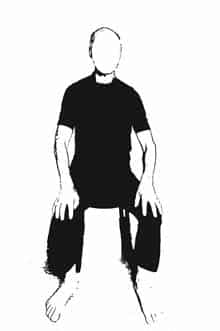
The back is straight
The back should be straight and in a natural position. So the energy flows well through the body. In India and China, they believe, there are channels, running through the backbone and through the body transporting energy. A straight back supports this energy flow, prevents pain of the back and gives space for the internal organs.
Imagine that the vertebrae lie on top of each other like a pile of coins. The back automatically straightens when you tighten the chin a little or when you imagine a small thread pulling up your head. You sit neither far forward nor leaned far back. If you’re sitting on a chair, you shouldn’t lean on, because you could become sleepy.
Sitting on a cushion
If you want to meditate on a pillow, choose a special meditation pillow. Ordinary pillows are not suitable because they are too soft and do not support the body. Ideal cushions are solid, round without buttons, about 15 inch in diameter and at least about 5 inch high, filled preferably with Kapok (soft plant fibers) or spelt (spelt or buckwheat).
Meditation posture crossed legs (tailor’s seat)
Most people are not used to sitting on a pillow for long. They usually are spontaneously sitting crossed legs (tailor’s seat). That’s not a good choice, because the muscles quickly hurt and the seat becomes uncomfortable. Therefore, support the knees by cushions or put another firm base – such as yoga pads – under your knees to give firm support to the legs and the whole body.
In tailor’s seat, it is also difficult to keep your back really straight. Put something under your coccyx – a small pillow or a rolled-up blanket to support the back. There are also special meditation cushions that are optimized for sitting in the tailor’s seat.
Sitting on a pillow
If you sit on a pillow and your knees rest on the floor, the body has good stability and allows meditation without pain – when our legs have become accustomed. You need a little bid of patience.
The stability of the body is supported when the hands rest on the knees. It helps if there is some distance between the elbow and the body.
Sitting becomes easier if you take a high pillow or two of them. It helps when you use a blanket or a flat mat, because feets and knees could hurt on a hard underlay. And there are special wooden meditation benches that can make the seat more comfortable.
Be patient
You sit in a certain composure – quite naturally. For a sitting position to really work and to become comfortable, you may need to practice for a certain time. Be patient.
Meditation postures
Here is a list of positions. Some of them are quite challenging. The Buddhas are usually depicted sitting in full lotus. Each feet lies on the other thigh. This is a wonderful yoga position with many advantages – but you may have to practice for a long time until it really works and is comfortable.
In the simpler version, only one foot lies on the opposite thigh. That’s half lotos.
When feet lie further down in the squats it’s quarter lotos. You can also put your legs and feet next to each other. The difference to the tailor’s seat is that both knees rest on the underlay and the body becomes much more stable.
And you can ride on a pillow. For this purpose you can also take two pillows.
meditation tips #02
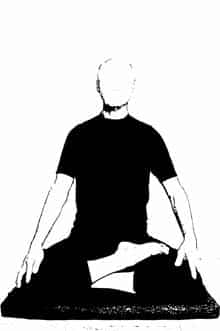
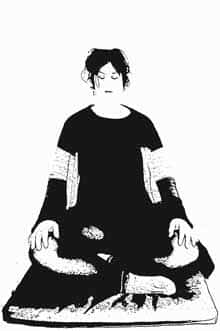
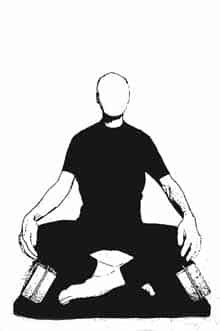

Meditation tips: Meditation Room
You can meditate anywhere. But you shouldn’t make it unnecessarily difficult.
Avoid anything that distracts or disturbs
If the practice is not yet well-founded, everything distracts and brings you back to normal consciousness.
Avoid noisy places – no human voices, no traffic noise, no mobile phone bells.
Avoid places with extreme temperatures, with draughts, strong sunlight. The place should be clean and fresh. Find a place that supports meditation.
Don’t choose a room where people are coming and going. Great is a special meditation room. It doesn’t have to be large. A separate room helps the good energies to stay. Perhaps there is a room that is not often used – such as a guest room or a former children’s room. It also can be a corner in an otherwise used room.
If possible, nothing should remind of everyday life, urgent tasks and work. Bedrooms could be associated with sleep, a workspace with work.
A space of silence
A space that radiates peace and silence. A place without stress. A beautiful room, as bright as possible, tidy, clean, without things that do not belong to a meditation room
The room should have a window so fresh air can come in.
A place where you feel comfortable
If you’ve targeted a place, see if you really like it. You should feel comfortable.
Some talk of power places. You will feel the right place. If you feel uncomfortable, then it is not right. Maybe you have a favorite place in your apartment, a place where you really feel good.
What belongs to a meditation room?
First and secondly a meditation pillow or a chair. Maybe a mat and a singing bowl.
As little distraction as possible. Only items that make you feel comfortable. Banish everything you don’t want. An empty white room and a meditation pillow is enough.
Inspiring things
Create something that inspires you and supports your meditation.There could be a single flower, a special piece of wood, a candle flame or an image, your meditation object. The image of a master, an image of Buddha or of Holy Mary. Or a calligraphy, an ink painting of a circle.
Zen Buddhists may hang an image with a calligraphy. Tibetan Buddhists use an altar with many sacred objects, images, and figures. Others build up an altar full of devotional images, with statues, candlesticks, incense vessels.
Nothing distracts in a white room. Maybe you’ve a certain connection to colors. This could be the color orange. Or gold? Then keep your space in these colors.
You can ask beings for support and offer them symbolic offerings – a bowl of rice, fruits, flowers.
Habits
It’s about our minds. Right habits support meditation like regularity, certain times and a specific place. I don’t have to make a new decision over and over again. Should I meditate today or not?
If you always meditate at the same place, in the same environment, it will create a habit. If things go well, it will evoke something like meditation in you simply by visiting this special place.
Through regular meditation, deep rituals, prayer, puja and guru yoga, love and worship, and compassion, this space will soon radiate silence and energy. A special atmosphere will surround you. Practice turns your profane apartment into a temple.
Meditation outside
You can also meditate on the terrace, on the balcony or in the garden. And also in a park, on a quiet, mossy and mosquito-free place in the forest!
When you meditate outdoors, choose a power place, a quiet place that is supported and carried by its extraordinary energy – a lonely spot between flowering flowers, under strong trees, at springs, in caves.
Or go to a place that has served devotion for a long time, to an old church.
Preparing for Meditation
Cleanse yourself before you meditate and clean and ventilate the room. So you are clean inside and outside, free of disturbing, dark, profane thoughts!
Imagine the place where you are great, like a heavenly palace. And you too are beautiful, enlightened in your essence. Now is the right time. And the method you use is great.
meditation tips #02a
Meditation tips: Reasons to Meditate
Good Effects of Meditation:
Your mind will change – even your brain structures will measurably change. This has serious positive effects.
You will become healthier, more relaxed and more conscious.
The world will look more friendly.
You will be happy.
You will get to know yourself.
You will find answers to final questions.
The details are coming now.
Brain and mind will change
Science can look into our brains and has found that brain is restructured even after a short period of practice, creating neural circuits and forming synapses. Some areas are becoming stronger, areas responsible for emotions, especially compassion, as well as the areas for learning and mindfulness.
Brain aging is delayed.
So a lot changes.
World will meet you more kindly
My own experience: I used to be a pretty closed person – something like a can with two small holes for looking. I was suspicious and didn’t expect anything good from people. I made myself invisible, and I only participated when absolutely necessary.
That’s when meditation met me. I sat down in my bedroom and practiced. It felt good and I did’t stop.
Later I searched and found people who also meditated.
At some point I found, that my protective armour was no longer needed. People were mostly kind to me.
I had probably changed. There wasn’t fear no longer. It became nice to be with people.
Meditation will reduce your problems
You may feel miserable, you are sick, you are afraid, you feel lonely. Meditation will help.
Patience
Meditation makes you patient. Thoughts and feelings are not so important any more. There is nothing to do. It might feel boring. At some point, you forget that you’re bored. You become patient.
You see what is going on in your mind
Meditation shows, what is going on in your mind. Movements become transparent. They slow down. As distractions disappear, the mind becomes calm. We see what is.
Relaxed and satisfied
You will be relaxed, balanced and satisfied. Why?
1. because your mind changes, there aren’t so many useless and frightening thoughts and emotions.
2. because you realize what you are doing. You are no longer caught by so many useless thoughts and feelings.
You gain stability and inner peace. There will be less stress.
You learn to love yourself.
You can concentrate, you are mindful, you can see what’s going on this moment.
You become healthier. Blood pressure decreases and thus the likelihood of heart disease. You will feel less pain. The risk of depression and dementia decreases.
Surely you will endure illnesses more easily.
Meditation even helps to lose weight because you become more mindful.
Meditation solves all problems
Why?
Problems need thoughts. Without thinking, no one can worry. Problems may continue to exist. For the one who meditates, however, they no longer have any space.
Direction changes
Don’t expect everything to change right away. It’s about watching. You look what your thoughts and emotions do. You watch them like something going on outside.
There is no particular intention. There is no impatience. Just looking. There’s a care, there’s a sparrow bouncing and another one is jumping, there are some people walking.
This is how meditation goes. The cars and sparrows and people are your thoughts and emotions. You watch. And nothing else.
You are no longer looking what’s going on outside; you look what’s happening within yourself. A change of direction. And this change of direction does something in you.
Becoming happy
All people look for happiness. And everyone is looking for happiness outside. You want a good partnership, a satisfying profession, a lot of money, a car, a house, holidays. And the more you get, the more you want. These wishes never end.
Outer happiness brings satisfaction. But this satisfaction does not stay. After a short time you no longer feel joy and happiness. You has got this apartment you always wanted and after a while you get used to it and eventually you will feel like before. This is probably true of all fulfilled wishes. After some time you want something else.
Lasting happiness is possible. Ongoing happiness only comes from within. This change of direction is necessary. Through meditation, by looking inwardly, you will find unconditioned happiness – happiness that depends on nothing else. No external things or circumstances are needed.
That’s the trick of yogis and monks. They own nothing and are happy.
Answers to final questions
Maybe you care about the big questions: What is the ultimate truth? What is our task on earth? What is enlightenment?
Meditation is a means to experience yourself and what is around you. Ultimately you will know what is – by your own experience.
Becoming a good person
Some Buddhists summarize their doctrine in this way: Do no harm, do good, work with your mind. That’s what the Buddhas teach.
Do not harm and do good, that’s what many people accept and probably all religions.
If I want to stop harm and to do good, I have to work with my mind.
A very important way to work with your mind is meditation. I have to find what mind is. I have to find my mind and watch.
meditation tips #03
Meditation Focus – Meditation Object
Meditation Focus. Thoughts jump like little mice. That’s why mind needs a focus in meditation – something to deal with.
Distraction
Meditation is ultimately the state without distraction. Our minds are focused only on one single point. However, this ideal is rarely achieved.
Meditation is about letting mind free, just as letting a trapped bird fly into the sky. Mind is on holyday. There’s no need to think all the time.
Meditation Focus
It’s not that easy – to let go thoughts. Thoughts and emotions are popping up again and again. It’s a natural function of mind. And. Thoughts will catch us. In our minds we are somewhere – but not here and now.
We need a lasso. Meditation Focus. Something, that keeps our mind at one point. So thoughts no longer swirl around and jump like little mice. Mind has something to play with.
You should focus on something. But not too strong. Something should gently catch attention.
Meditation object
So choose a meditation focus. That can be anything.
Number one is breath. We count our breaths: one in, two out, three in, four out, five in … And at ten, we start again at one. And on and on.
And soon we are distracted. At some point we realize that we just count twenty-seven. Oh, I should count to ten and then start with one again.
Or at some point I realize that I’m following pictures from my last holiday. I see a wonderful sunset in my mind. Breath counting is completely forgotten.
Don’t feel anger! Annoyance is also a distraction. Start again without emotions: inhale one, exhale two …
Breath as meditation focus
Breathing as meditation focus is quite practical because we always have it near us. And also because calm breaths support a good state of meditation. Slow conscious breathing brings a calm mind quite automatically, just as frantic breathing makes us restless.
We know that we breathe faster, when we are excited. And calm breathing makes a calm state of mind. We take a deep breath to calm down.
Breathing is automatic. We don’t have to think about whether to inhale or exhale. If we turn our attention to breath, something will change. It’s not automatic anymore.
In meditation, breath becomes calm. It becomes almost unnoticeable. It may be much slower than usual. And when you come aware, you might be worried. It’s all right. It’s the attention that is changing. Breath will not stop.
Breath counting is one of the most well-known meditation objects and is especially recommended to people who begin meditation.
Other meditation items
Other meditation objects are images, flowers, candle flames or small inspiring word sequences. Or even pain in the knee or noise on the street.
And. Meditation objects are neither necessary nor sufficient. But helpful.
There is also a meditation without focus. You can start with an object as a stepping stone and jump and fly up into empty space. Good luck!
meditation tips #
Meditation tips: Why to meditate with open eyes?
You can meditate successfully with open eyes and with closed eyes. This is already shown by the fact that Hindus usually meditate with closed and Buddhists with open eyes.
If you are used to meditate with eyes closed, try to keep your eyes open while meditating. This is unusual in the beginning. Maybe you’re more distracted.
When You are meditating with a figurative object as focus it only works with open eyes. There is nothing else to say.
Are there more reasons?
We show that we are not closing in. All senses remain open. We live in the world and see everything. We do not run away, and we live in peace with the world. But we will not allow ourselves to be captured by the world.
Open eyes interrupt the flow of thought. Thoughts lose strength. But thoughts do not automatically lose strength.
The historical Buddha is shown with half-closed eyes. May be you need some practice with a meditation without focus.
Let your eyes go wide! That is, the gaze rests gently on the objects. I like to demonstrate this with my thumb. I look at my finger and without changing my gaze, I try to see what is right and left. Although the eyes are objectively directed to the finger, they capture the entire field of vision and all of the room. The eyes are open, but not fixed. You perceive the whole field of view at the same time.
The eyes are open, but what they see don’t touch you. You don’t perceive more than if your eyes were closed. And yet a part of you gets everything. When you look like this, the thoughts fade and stop.
Look down a bit and change the position of the eyes as little as possible.
The eyes are simply left as they look. Do not follow the objects.
Try not to blink so much. This is a sign that thoughts are there.
And at some point the mind is distracted again. My thoughts have caught me. That is natural. The most important thing is to continue practicing.
meditation tipps #04b
Meditation tips: Concentration
In meditation, concentration is needed to maintain awareness. Otherwise thoughts and emotions will completely absorb us.
Learning meditation
What we call meditation is first of all practice. We create the conditions for a meditative state. It’s like everything you learn. If I want to skate, I have to learn and practice how to do it. I will fall on my butt a few times. And at some point I glide and it’s like flying, without even wasting a little thought on how I do it.
Meditation means to wake up. It is more than just waking up from sleep in the morning. We’re always busy, we’re always distracted. Now we are practicing to be not distracted. You need some practice, effort and concentration.
In the first step, attention does not exist in a vacuum. It needs a focus, a meditation object. We will focus on this subject of meditation – for example on our breathing.
Concentration
In this phase of meditation we need concentration to maintain awareness. Otherwise we are completely captured by what rises in our minds, we are completely distracted again and the focus of meditation is forgotten.
Be mindful, but not fully tensed. There should be some ease, some serenity and the confidence that it will be okay.
According to Patanjali, the old master of meditation, concentration or fixation comes first. He says:
“Fixation means focusing thinking and feeling on a single object of experience.”
What he calls meditation comes, when fixation is finished.
Middle Way
The Buddha Shakyamuni has always recommended a middle way. Once a student, a former musician, asked, how to meditate. The Buddha said, you know, how to handle your instrument, when playing music. A string must not be stretched too tightly or too loosely. Likewise, the meditative concentration should not be too strong or too weak.
Don’t look for quick success. Develop a balance between wakefulness and relaxation.
Go step by step
You start with quite a lot of concentration – let’s say 75% concentration. And over time, it becomes less and less. Maybe at some point you only need a concentration of 25% and 75% of relaxation. And later you only need 10% of concentration. And even later no concentration is necessary. This even Patanjali would call meditation.
In perfect meditation, everything is there at the same time – awareness, mindfulness and remaining – effortlessly. It’s just there. It comes naturally – when you have reached this point.
meditation tips #04c
Meditation tips: Distraction
Many people find they are distracted during meditation. That is a relevant observation. This will happen almost always.
Meditation can be defined as the state of no distraction. That is a high goal. What we call meditation is about exercise this state. That does not mean that we have achieved it.
It’s natural that something distracts us. We have already reached to a certain point when we notice that we are distracted. That’s a sign of mindfulness.
Our world is a world of distraction. All that surrounds us is distraction. It is hard to escape this distraction and to become mindful.
Our society want us to buy and consume. So our world constantly tries to catch our attention. And we surround ourselves with so many things that want our attention: telephone, mobile phone, television, advertising, newspapers, films, exhibitions, theaters, shows, meetings with friends, party, disco – the list is immeasurable.
So it’s already good just to see our natural environment – the trees, meadows, houses, people. Rest from all the other distractions.
Sometimes I think I am sitting in a dark can and I am looking out only through a small hole in it. What if I close this little hole for a moment and start looking into the can?
Of course we cannot turn our eyes and look inwardly. But we can imagine something. When we close our eyes, images appear. Sometimes I can look at them like real outside pictures.
These are probably memories, events that happen to me in the past. And something in me will link and expand these memories and create pictures, wake-up dreams or pure fantasy.
We are occupied with something that lies either in the past or in the future. And we don’t get what’s going on right now. We don’t sleep in the real sense. But we’re not really awake either.
If we dream and daydream, we can easily see that this is not the reality. But even if we look outward through our little hole in the can, it may not be the real world. It’s also a dream.
In any case, what we see through this hole in the can is not the ultimate reality. That is easy to see. We perceive through our sensory organs. And something in us creates our world from these data. There is, of course, the world. I can touch the tree in front of me or my hand gets wet when I dip it in water. But it’s not necessarily what I think it is.
What if we had other sensory organs, if we were equipped with bat ears? There are fish without functional eyes, which can still orient themselves well. Bees can see colors we cannot see. With other sensory organs, our world would be different. And also under the influence of drugs, the world seems very different.
Perhaps our world is just learned. Can we perceive the world in a completely different way? What is the ultimate reality?
In order to get an idea of this ultimate reality, a radical change is needed. We have to be here – now – completely. What exactly is now? We’re almost never – here.
Only when we change our gaze we will perceive what is now. What you see and hear and smell will no longer catch you. That may be over there. It’s there and disappears from Your attention.
Imagine you’re sitting in a bare room. You – and nothing else – no smell, no noise, nothing.
You’ll probably start distracting yourself. Even a bare white wall can distract. You may see cracks, stains. And there are movies in Your mind. You go on a journey mentally.
You might remember letting go of these distractions and being here. What will happen? Fears could arise, or the urgent wish to cough, it itches. You want to scratch.
Try to notice and endure. No more distraction. I am here. I know I’m there.
Now it’s going to be exciting. If you keep going, there will be only little distraction. You begin to look inside. The great research project called meditation starts.
Meditation tips: Cultivate a certain attitude
It’s quite hard to describe what to do, because it’s so subtle. You can meditate for years and of course something will happen. You will change. And yet there may be at some point a feeling of not getting any further and stuck.
How does meditation feel from within? How do I get there in a very practical way? You need a certain attitude.
Look at it this way: Do not think so much, what you can do wrong. Meditation is when there is nothing else to do. Mind is on holiday. It is a time of just being. There is no need for any tiring thinking.
There is a certain ease, perhaps also fearlessness, something of peace and vastness, free flowing without clinging. Release and relax. All is calm, natural. Be playful. Meditate with a smile.
Perhaps this is the key: do not approach meditation grimly. Meditate with a smile.
Motivation and Dedication Prayers
Motivation
Through the power and truth of this practice, may all beings experience happiness and the causes of happiness; may they all be free from suffering and the causes of suffering, and may they never be separated from the great happiness that is free from suffering and may they dwell in great equanimity, free from attachment and aversion.
The Dedication of Merit
Through this merit, may all beings attain the omniscient state of enlightenment, and conquer the enemy of faults and delusion, may they all be liberated from this ocean of samsara and from its pounding waves of birth, old age, sickness and death!
meditation tips #04a
Enlightenment
I’ve been asked sometimes what enlightenment is. Of course it’s daring to talk about enlightenment by someone who definitly is not. I speak about something I have heard of.
It’s nothing about Buddhism or religion. Also an atheist can attain enlightenment.
You can look from outside. One could say enlightenment shows what the world really is like. What is it like? Buddhists would say it is dreamlike, without solid substance. Everything is empty. Does that help?
It’s an experience and a state of mind. Just as there is sleep and being awake. And enlightenment is a non-dual state. We know: I am here and there is something else. There is a state where this contrast between me and this world outsite of me is eliminated.
A state of whom? That’s not easy to say. It’s not a state of me, because I am existing no longer. Not in the sense that there is no one left. There is sitting the same person as before. When someone looks at you, he or she sees you sitting on your chair.
But: There’s no longer this one who perceives the other. Both are one. Inside and outsite are no longer different. This is difficult to understand and describe. Just as it’s hard to describe how a mango tastes like when you’ve never eaten one.
It’s huge. It’s a enormous gift. So special – unlike anything you’ve ever experienced. You’ll never forget this moment.
And somehow it’s ordinary too. It feels natural. Not really spectacular. When it happens, there may even be a little bit of disappointment. That’s all?
Those who know this state say it’s comprehensible. Because it’s actually our natural state. That’s something we already have. It has always been with you. It’s like you built your house on a gold treasure and you don’t know about it. Some day you dig and find it. It’s new to you. But it’s always been there.
It’s nothing you’re re-creating. So. We’re actually already enlightened. The problem is we don’t recognise.
It’s like sky. It’s always wonderfully bright up there in deep blue. But sometimes there are clouds. So we can’t see the sky.
In such a moment there’s no ego. There’s none to care about to whom it is given.
Without ego, there’s a universal compassion, the huge desire that all beings may participate in this state, a universal sense of love for all sentient beings and great gratitude.
This state will not stay. It may occur very briefly or even a little bit longer – maybe for a few minutes or even half an hour. In any case – it’s not permanent.
That’s what zen people call satori. These are moments. And then you’re back and all your thoughts and emotions.
And there’s enlightenment. Someone is fully awakened. That’s something total different. That means the whole being is in this state all the time. An enlightened being is always in this state. Perhaps there are hardly any of these people. Perhaps enlightenment is only possible after death and in very few exceptional cases. People like the Dalai Lama are said to be enlightend. Perhaps that is true.
And when it comes, it’s the same enlightenment as the enlightenment of the historical Buddha – exactly the same. Everyone who has this experience is also a Buddha, a fully awakened one.
meditation tips #05
